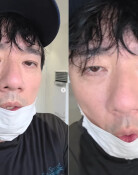What the Salary Peak System Feels Like
What the Salary Peak System Feels Like
Posted July. 01, 2005 05:54,
I wore a jumper at work for the first time in my 25-year career as a bank employee. It has been only fifteen days since I have done so, which is why it feels somewhat strange to me. But I am sure that I might get accustomed to it sooner or later.
On June 29, Dong-A Ilbo met Hong Gyeong-seok, a 56-year-old general manager of the Export-Import Bank of Korea (Korea Eximbank). He was working at a factory for Neosemitech, a manufacturer specializing in gallium-arsenide semiconductors, in Dangha-dong, Seo-gu, Incheon. On his calling card, his job was described as standing advisor for Neosemitech, not as a bank general manager.
Hong was the first to be applied to the salary peak system, which Korea Eximbank adopted last January. He will be working for Neosemitech, the banks partner, as a long-term consultant and be paid by the bank until his retirement in August 2008.
This year, his salary was reduced to the 90% level of last year, right before the application of the salary peak. The figure will continue to shrink to 75% next year, 60% in the year after next year, and 30% in 2008 when he retires.
Though my salary is cut, I am satisfied that I can invest my long-time experience in the future of a small-sized business with a great growth potential and that I got an opportunity to prepare for my life after retirement, said Hong.
A growing number of enterprises, including Korea Eximbank, are introducing the salary peak system. Last year, Daewoo Shipbuilding and Marine Engineering (DSME), Korea Water Resources Corporation (KWRC), Korea Appraisal Board (KAB) and others implemented the salary peak system. This year, the Export-Import Bank of Korea, Woori Bank, Korea Development Bank (KDB) and Munhwa Broadcasting Corporation (MBC) introduced the system.
Some manufacturers, such as Hyundai Motors and Choil Paper, as well as Korea District Heating Corporation (KDHC) and Korea Agricultural & Rural Infrastructure Corporation (KARICO) are also considering an adoption of the salary peak system in an effort to relieve the burden of increased labor costs attributed to the aging of their employees.
Some businesses that have already implemented the salary peak are hiring more new employees by utilizing saved labor costs. In this regard, the salary peak system is receiving huge attention as an alternative for catching two rabbits at oncecoping with an aging society and resolving the youth unemployment issue.
In the case of Taihan Electric Wire, which adopted the salary peak in 2003 for the first time as a manufacturer, it was labor unions who proposed an introduction of the system to the management, understanding the crisis faced by the company. Now, the Federation of Korean Industries (FKI) and other business organizations are calling for an adoption of the system in a way to relieve the burden of labor costs.
Labor experts indicate that in the era of high salaries, low growth, and an aging trend, the salary peak system is the most practical option for lessening the burden of businesses and preventing the early retirement of workers at the same time.
The salary peak system will be adopted in more workplaces as an increasing number of workers hope to work until their retirement age or longer, even though they will be paid less, rather than face an unstable evening of their lives after retiring in their early- or mid-fifties, forecasted Kim Jeong-han, a researcher at the Korea Labor Institute (KLI).
The salary peak system, however, might be a new factor for possible labor-management conflicts as labor circles, including the Korean Confederation of Trade Unions (KCTU), oppose the salary peak system, citing that the system would lead to a wage cut for workers.
Joong-Hyun Park Sung-Won Joo sanjuck@donga.com swon@donga.com



![[김순덕의 도발] ‘李부터 연임’ 개헌, 이 대통령은 가능성을 말했다](https://dimg.donga.com/c/138/175/90/1/wps/NEWS/IMAGE/2026/01/16/133172656.1.jpg)



